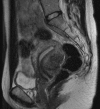The benefit of adenomyomectomy on fertility outcomes in women with rectovaginal endometriosis with coexisting adenomyosis
- PMID: 30254864
- PMCID: PMC6113964
- DOI: 10.1016/j.gmit.2016.08.002
The benefit of adenomyomectomy on fertility outcomes in women with rectovaginal endometriosis with coexisting adenomyosis
Abstract
Study objective: To evaluate the effect of removal of coexisting adenomyosis on fertility outcomes in women with rectovaginal endometriosis.
Design: A retrospective cohort study.
Setting: A general hospital.
Patients: A total of 190 women who underwent laparoscopic nodule excision surgery for rectovaginal endometriosis between April 2007 and December 2012.
Interventions: Surgical excision of the rectovaginal endometriosis and coexisting uterine adenomyosis. Statistical analysis for fertility outcomes.
Measurement and main results: A total of 119 women desired postoperative pregnancy. Coexisting adenomyosis was found in 21% of the women. The overall clinical pregnancy rate was 41.2%. The only determining factor associated with a successful pregnancy was "age at surgery". Clinical pregnancy rates with or without adenomyosis were 36.0% and 42.6%, respectively. We found no significant difference in clinical pregnancy rates between the groups.
Conclusion: There is a possibility that surgical removal of coexisting adenomyosis positively effects fertility outcomes in women with rectovaginal endometriosis. However, it is also important to note that the age at surgery was a critical factor for successful pregnancy.
Keywords: adenomyosis; endometriosis; pregnancy; rectovaginal; surgery.
Conflict of interest statement
Conflicts of interest: The authors declare no conflicts of interest.
Figures


Similar articles
-
Pregnancy outcomes in women with infertility and coexisting endometriosis and adenomyosis after laparoscopic surgery: a long-term retrospective follow-up study.BMC Pregnancy Childbirth. 2021 May 18;21(1):383. doi: 10.1186/s12884-021-03851-0. BMC Pregnancy Childbirth. 2021. PMID: 34006232 Free PMC article.
-
Surgical treatment of deep endometriosis with adenomyosis externa: a challenging case in an infertile woman.Fertil Steril. 2021 Apr;115(4):1084-1086. doi: 10.1016/j.fertnstert.2020.11.004. Epub 2021 Mar 6. Fertil Steril. 2021. PMID: 33750620
-
Who will benefit from uterus-sparing surgery in adenomyosis-associated subfertility?Fertil Steril. 2014 Sep;102(3):802-807.e1. doi: 10.1016/j.fertnstert.2014.05.028. Epub 2014 Jun 19. Fertil Steril. 2014. PMID: 24954774
-
Reproductive, obstetric, and perinatal outcomes of women with adenomyosis and endometriosis: a systematic review and meta-analysis.Hum Reprod Update. 2019 Sep 11;25(5):592-632. doi: 10.1093/humupd/dmz012. Hum Reprod Update. 2019. PMID: 31318420
-
Conservative surgical treatment of adenomyosis to improve fertility: Controversial values, indications, complications, and pregnancy outcomes.Taiwan J Obstet Gynecol. 2015 Dec;54(6):635-40. doi: 10.1016/j.tjog.2015.05.003. Taiwan J Obstet Gynecol. 2015. PMID: 26700977 Review.
Cited by
-
The Role of Three-dimensional Laparoscopy in Gynecology: Time to Revise Our Perspective?Gynecol Minim Invasive Ther. 2023 Dec 7;13(1):1-3. doi: 10.4103/gmit.gmit_99_23. eCollection 2024 Jan-Mar. Gynecol Minim Invasive Ther. 2023. PMID: 38487617 Free PMC article. No abstract available.
-
Laparoscopic Excision of Severe Deep Infiltrating Endometriosis.Gynecol Minim Invasive Ther. 2022 Feb 14;11(1):76-77. doi: 10.4103/GMIT.GMIT_26_21. eCollection 2022 Jan-Mar. Gynecol Minim Invasive Ther. 2022. PMID: 35310119 Free PMC article. No abstract available.
-
Transvaginal Natural Orifice Specimen Extraction: A 10-step Approach for Laparoscopic Excision of Deep Endometriosis Infiltrating the Rectosigmoid.Gynecol Minim Invasive Ther. 2024 Feb 23;13(1):62-63. doi: 10.4103/gmit.gmit_52_23. eCollection 2024 Jan-Mar. Gynecol Minim Invasive Ther. 2024. PMID: 38487604 Free PMC article. No abstract available.
-
Evaluation of Deeply Infiltrating Endometriosis by Preoperative Magnetic Resonance Imaging in Patients with Adenomyosis.Gynecol Minim Invasive Ther. 2023 Dec 28;13(2):105-110. doi: 10.4103/gmit.gmit_59_23. eCollection 2024 Apr-Jun. Gynecol Minim Invasive Ther. 2023. PMID: 38911300 Free PMC article.
-
Effectiveness of Laparoscopic Adenomyomectomy on Perinatal Outcomes.Gynecol Minim Invasive Ther. 2023 Jan 17;12(4):211-217. doi: 10.4103/gmit.gmit_45_22. eCollection 2023 Oct-Dec. Gynecol Minim Invasive Ther. 2023. PMID: 38034106 Free PMC article.
References
-
- Garry R. Is insulin resistance an essential component of PCOS?The endometriosis syndromes: a clinical classification in the presence of aetiological confusion and therapeutic anarchy. Hum Reprod. 2004;19:760–768. - PubMed
-
- Kishi Y, Suginami H, Kuramori R, Yabuta M, Suginami R, Taniguchi F. Four subtypes of adenomyosis assessed by magnetic resonance imaging and their specification. Am J Obstet Gynecol. 2012;207:114.e1–e7. - PubMed
-
- Barri PN, Coroleu B, Tur R, Barri-Soldevila PN, Rodriguez I. Endometriosis-associated infertility: surgery and IVF, a comprehensive therapeutic approach. Reprod Biomed Online. 2010;21:179–185. - PubMed
-
- Ferrero S, Anserini P, Abbamonte LH, Ragni N, Camerini G, Remorgida V. Fertility after bowel resection for endometriosis. Fertil Steril. 2009;92:41–46. - PubMed
-
- Darai E, Carbonnel M, Dubernard G, et al. Determinant factors of fertility outcomes after laparoscopic colorectal resection for endometriosis. Eur J Obstet Gynecol Reprod Biol. 2010;149:210–214. - PubMed
LinkOut - more resources
Full Text Sources
Other Literature Sources
Miscellaneous
